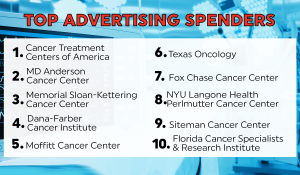We need to stop them
By
What every American doesn’t know:
Cancer is also helping some Americans become exceedingly rich. And these
Americans will do most anything to keep their windfalls coming, even prey on
the fragile psyches of the families cancer strikes.
Top cancer treatment centers, the
consumer group Truth in Advertising charges in a new report,
are “deceptively promoting atypical patient experiences through the use of
powerful testimonials.” Back in 2005, U.S. cancer centers spent $54 million
showcasing these deceptive testimonials. By 2014, that annual outlay had more
than tripled to $173 million.
 One typical testimonial in
this advertising barrage features an effusively grateful patient named Carl, a
pancreatic cancer survivor. The ad never mentions that
pancreatic cancer five-year survival rates run just 8.5 percent.
One typical testimonial in
this advertising barrage features an effusively grateful patient named Carl, a
pancreatic cancer survivor. The ad never mentions that
pancreatic cancer five-year survival rates run just 8.5 percent.
“Any cancer center can find a
patient who has beat the odds,” notes the new Truth in Advertising report, The Deceptive Marketing of Hope.
“But using that atypical experience to play on the hopes and fears of such a
susceptible patient population has real consequences.”
Cancer patients deciding where to go for treatment, for instance, may be so impressed by a testimonial that they stop looking for treatment alternatives and travel out of state, ignoring “closer, better, or less expensive options” much closer to home.
Misleading marketing is working
exceedingly well — for the top brass at the for-profit cancer centers that now
dot the American health care landscape, outfits like the Cancer Treatment
Centers of America chain. This company has relocated its headquarters to Boca
Raton, a prime South Florida wealth magnet.
The CEO who engineered this
relocation, a former luxury hotel executive, celebrated the move by picking up
a new $2 million waterfront home.
The company’s current chairman,
Richard Stephenson, has found the cancer treatment business particularly
rewarding. This Illinois mega-millionaire, Johns Hopkins University biomedicist
Steven Salzberg points out, has used
“the profits from his cancer hospitals to support his favorite right-wing
causes.” In 2012 alone, Stephenson poured $12
million into the Tea Party.
The bad actors pumping out
misleading cancer treatment ads also include, somewhat surprisingly, many of
the nation’s most prominent cancer-treatment not-for-profits.
The most celebrated of these, the Memorial Sloan Kettering Cancer Center in New York, shelled out $11.7 million last year marketing testimonials from survivors like “Joanne S.,” a stage-four lung cancer patient. Such patients overall have a 4.7 percent survival rate.
The most celebrated of these, the Memorial Sloan Kettering Cancer Center in New York, shelled out $11.7 million last year marketing testimonials from survivors like “Joanne S.,” a stage-four lung cancer patient. Such patients overall have a 4.7 percent survival rate.
Misleading cancer patients pays
quite handsomely for nonprofit executives, too. Memorial Sloan Kettering CEO
Craig Thompson pulled down $6.7
million from his day job in 2016 and nearly another $600,000 last year serving
on the corporate boards of two pharmaceutical companies.
Outrageously excessive executive pay, numbers like these suggest, amounts to an economic “carcinogen” — a cancer-causing agent that first takes hold in the for-profit private sector, then spreads throughout our body politic, corrupting everything it touches.
The best way to protect against
this corruption? We could start by leveraging the power of the public purse
against enterprises that pay out excessive executive rewards.
Lawmakers, for instance, could
deny subsidies to companies that pay their top executives over 25 times what
their typical workers are making.
A move along that line would have stopped the Cancer Treatment Centers of America chain from qualifying for $2.4 million in state and local government subsidies when the company relocated to Boca Raton.
A move along that line would have stopped the Cancer Treatment Centers of America chain from qualifying for $2.4 million in state and local government subsidies when the company relocated to Boca Raton.
America’s big-time corporate
execs currently average over 350 times what average workers are taking home. We
may not ultimately be able to vanquish cancer. But we can certainly vanquish
the CEO pay excess that so exploits cancer’s victims.
Sam Pizzigati co-edits
Inequality.org, where an earlier version of this appearaed. His latest book, The Case for a
Maximum Wage, has just been published. Follow him at @Too_Much_Online. Distributed by
OtherWords.org.
